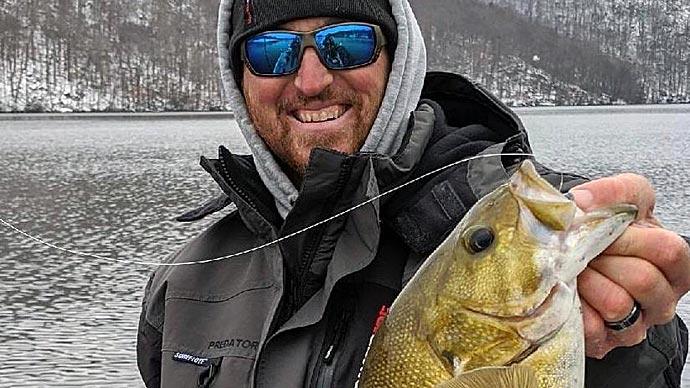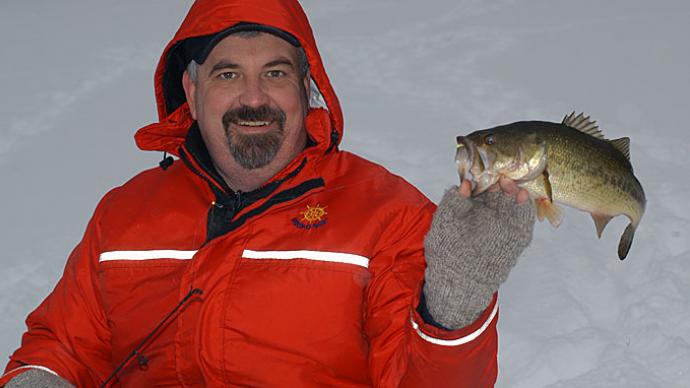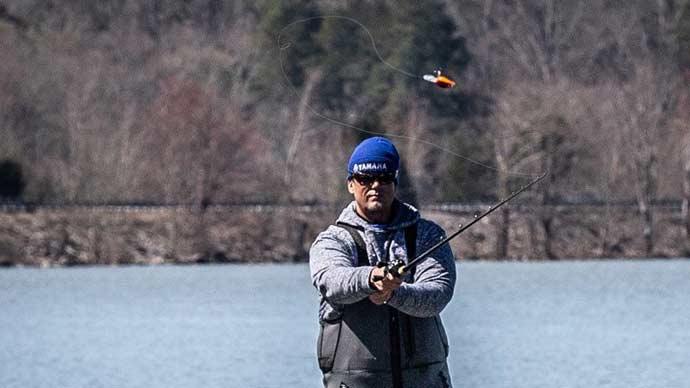
When we get into the colder months of the fishing season, many of us struggle to catch bass, making it an easy excuse to do something else until the bite picks back up again. So, let's take a closer look at cold-water finesse tactics, including a few that may surprise you. So, bundle up, dress warm, let's hit the water, and see what we can do to put bass over the side of the boat.
What It Takes To Catch Bass In Cold Water
During the off-season, it can sometimes seem that every day on the water will be a grind. There will be days when the bites will come easy, but there will also be days when you may fish for 8 hours and put the boat back on the trailer with only a few or no bites to show for the day. You must take some of these days with a grain of salt and write them off as learning experiences. The better you get at fishing through these tough bite days, the better fisherman you'll become.
One key at this time of the season is to dress warmly. I overdress for the day and the conditions. I have always thought I could take clothes off if I get too warm. But if I underdress and get cold, I cannot warm up and let the weather conditions win that day.
AFTCO makes a full line of clothing for all weather conditions built to serve fishermen. A Reaper sweatshirt is a must-have for fishing in cold weather. Wear your life jacket when fishing during these cold-water periods and watch your step in the boat. If you end up in the water, you'll have a limited time to get out before hypothermia starts. So please be extra cautious when on the water at this time of the season. I always carry extra clothes in the boat or truck just in case something like this happens. Knock on wood, I have not ever had to use these items for myself, but I have given dry clothes to somebody that needed them after getting back into their boat. I also carry a small propane heater in my boat that I'll fire up from time to time to warm my hands back up. I always turn it off before moving to another spot. I also put this heater in a small bucket so it can't be knocked over and create any problems.
Electronics Play An Important Role
Let’s talk cold-water tactics. Electronics will play a big part in the game at this time of the season as bass are grouped up and often won't be far from their daily food source. Spend time driving around in key areas looking for signs of bass and bait. Making a late-season trip to Table Rock one year, my partner and I would start our mornings in the creek arms looking for signs of shad and wait to see if any bass would soon show up to start feeding. It was one of the easiest ways to find active bass. Then we would turn towards our electronics to see if we could find other bass that wouldn't show themselves.
Forward-facing electronics also played a big part in seeing and watching how the bass would relate to the school and position themselves when feeding. We saw how they reacted to the baits we threw at them. This helped us dial in the baits to trigger strikes.
Drop Shot
The first time I saw a new tactic called “drop shot fishing” was by Shin Fukae when he was fishing an FLW event decades ago. Shin had a spinning rod in his hand and was dropping a bait down to the fish below his boat that he saw on his electronics. So that was the opening volley of drop shot fishing in the US.
Through the years, many things have changed regarding drop shot fishing. Rods, reels, line choice, and even now, drop shot fishing has its line of baits to help fishermen put more bass in the boat.
My standard drop shot setup is a 7' Denali Lithium Pro medium-Light to medium-action spinning rod matched with a Denali Fission Pro spinning reel 200 size or a 300 size because the larger spool reduces line twist. Many fishermen are spooling their reels with braided line, teamed with a fluorocarbon leader matched to the fishing conditions. I use 12lb to 16lb Sunline Asegai Braid (High Vis Yellow), teamed with an 8-10lb Sunline Maboroshi fluorocarbon leader. Maboroshi leader comes in 5 assorted color segments, so you can trim the line to the color that matches the bottom conditions you're fishing. This helps to disguise the leader when fishing in clear water conditions and during the wintertime when the water is at its clearest point of the year.
Bait choice for this time of the year, I have a few particular go-to’s. Big Bite Baits has introduced a new lineup of scented baits called Scentsation. I have been using three baits in the Scentsation lineup with remarkable success, the Skinny Stick, SoMolly, and a Smasher. These are excellent drop shot baits, either nose hooked or rigged onto your drop shot hook. The Skinny Stick can also be rigged wacky when needed, giving you a different presentation and look.
Free Rig

The Free Rig became popular in the last few years in finesse situations, and I have found a place for it in my cold water fishing. If you're not familiar with the Free Rig, you take a sliding weight and slide this onto your line and tie your worm hook onto the end of your line. Next, select your plastics of choice and thread this onto your worm hook Texas style.
When you make your cast, the weight will separate from the plastics and go to the bottom, with your bait following behind unweighted. This allows your bait to slowly work to the bottom, with a gliding action triggering more bites as it falls.
Another way I fish the Free Rig is to move the bait and then feed it some line to let your bait float up a little, and pause before you move the bait again. On tough days, the only way I could get bites was when I would feed the bait some line, and it would come off the bottom, and I could see my line start moving away. That was the time to reel down and set the hook.
Shaky Head
It's the sleeper baits in the winter fishing mix. During this period, Jeff Kriet first showed the bass world the Shaky Head. He was on the popular show Day On The Lake. They would take a BASS pro to a lake they had never been on before and give them eight hours to catch bass. In the first half of Jeff’s day, he did not have a fish, but in the show's second half, he pulled out a Shaky Worm presentation, and the rest is history.
A Shaky Head excels when the bite is super tough or you need to give the bass a distinctive look. At this time of the season, I rig my Shaky Head with a 6" finesse worm, but I have also been known to rig a 2.5" Big Bite Tube, craw, fluke, or a 4” Trickstick. By expanding my bait selection, I get better results if I keep changing baits letting the bass tell me what they want that day.
To help maximize my feel, I fish my shaky Head on a 7ft Denali Lithium Pro medium-action baitcaster, teamed with a baitcaster reel spooled with Sunline Asegai 16lb Braided line. In addition, I use a 10lb or 12lb Sunline Maboroshi fluorocarbon leader. If the bass drops my Shaky Head before I get a hook set, I'll switch to a monofilament leader. The built-in stretch that monofilament is often just enough not to let the bass feel me before I can get a hook set.
Finesse Swimbait
Bass will hold in and around cover if they can find it during this time. Examples that I'm talking about are deeper weeds and treetops. These are perfect situations to use a finesse swimbait rigged onto a jig head, which swims over this deeper water cover.
When picking a jig head, you don't need anything special. Choose a head to match the condition that you're fishing. I use a 3/16oz to 1/4oz Big Bite Swimmer Head. When it comes to baits, I use a Big Bite Finesse Swimmer or Suicide Shad as my bait choice.
To facilitate the smaller jig head setup, I fish this on a 7ft medium action Denali Lithium Pro spinning setup that is teamed with a Denali Fission Pro 200 spinning reel spooled with 12lb Sunline Asegai braid that has a 10lb Maboroshi fluorocarbon leader.
Make your cast and count the bait down until it's slightly above the cover or at the top of it, ticking it as it swims. This will help trigger bites along the way. The closer to the cover you can get, the more strikes you'll generate in your day of fishing.
Stickbaits
At this time of the season, I take a different angle when fishing a stickbait for a few distinct reasons. First, the baitfish are smaller than a full stickbait size, so I'll downsize my stickbaits to match the forage better. I also fish this on a spinning setup and fish with a smaller line choice.

I fish this presentation on a 7ft Denali Lithium Pro medium action spinning rod that is teamed with a Denali Fission Pro 200 spooled with 8lb Sunline Sniper fluorocarbon line. This setup allows me to cast my smaller stickbaits better, and with the 8lb line choice, I can still reach the same depths and, at times, deeper than I'm when using a full-size stickbait.
When fishing my stickbait in this fashion, I check all the finesse presentation boxes and catch bass along the way to match the conditions.
Two of the main stickbait I use for this presentation are a Rapala X-Rap Size 8 and a Fishing 13 Whipper Snapper 3.2". One thing I'll add to my bait if it doesn't have it's a feathered tail hook. It's very instrumental in getting bites during the cold water period. So even though your bait may not be moving, the feather continues to move, triggering bites along the way.
The key during this season is to cover water looking for signs of fish. When contact has been made, slow down and break the area down. Use some of the presentations that we covered to get the job done. When the bite dies down with one presentation, follow that up with another to see if you can't trigger a few more bites before you look for your next group of fish.
Dress warm and make the best of what the bass have to offer. You'll become a better fisherman because of it.
BassResource may receive a portion of revenues if you make a purchase using a link above.




